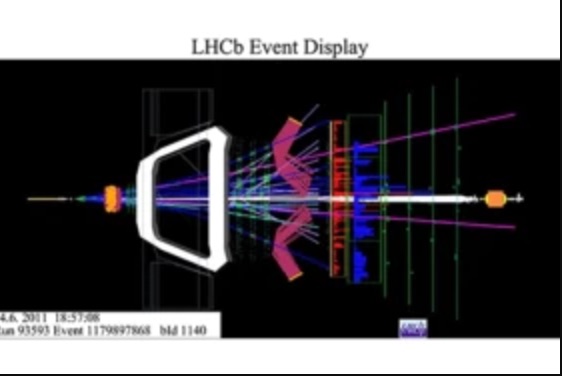Lawbreaking Particles May Point to a Previously Unknown Force in the Universe

For decades physicists have sought signs of misbehaving particles — evidence of subtle cracks in the "Standard Model:" of particle physics, the dominant theory describing the most fundamental building blocks of our universe. Although the Standard Model has proved strikingly accurate, scientists have long known some adjustments will be needed. Now, as a recent review paper in Nature documents, experimenters have started seeing suggestions of particles flouting the theory — but they're not quite the violations theorists were looking for.
The evidence comes from electrons and their more massive cousins, muons and tau leptons. According to the Standard Model, these three particles should behave like differently sized but otherwise identical triplets. But three experiments have produced growing evidence — including results announced in just the last few months — that the particles react differently to some as-yet mysterious influence. The findings are not yet conclusive, but if they hold up, "it would be a complete revolution," says California Institute of Technology theorist Mark Wise.
Tantalizing Signs
A shake-up in the Standard Model would be huge. This theory has formed the bedrock of particle physics research since it was fleshed out in the late 20th century. It carves the universe into twelve elementary particles that make up all matter, plus 'force-carrier' particles that transmit the fundamental forces of nature. (For instance, particles exert electrical or magnetic forces by exchanging transient photons.) Despite its successes, however, the Standard Model predicts nothing that would explain gravity or the dark matter thought to invisibly inhabit space. To marry particle physics with these larger-scale observations, theorists have proposed all manner of "new physics" — matter or forces beyond the Standard Model's menagerie. But most experiments have stubbornly upheld the theory with impressive fidelity, finding no evidence of the hypothesized particles or forces. [What the Higgs Is Going on with Mass?]
Since 2012, though, signs of particle misbehavior have started emerging from a less-explored corner of the Standard Model: a pattern called "lepton universality." Here "lepton" refers to the class of particles including electrons, muons and taus. The Standard Model predicts these three species should commune with one another and other particles in exactly the same way except for differences attributable to their unique masses — a commonality of behavior that accounts for the second term in lepton universality.
The first lepton surprise showed up in results announced in 2012 from the BaBar experiment at the SLAC National Accelerator Laboratory in Menlo Park, Calif. BaBar’s particle accelerator rammed together electrons and their antimatter equivalents, known as positrons. The collisions produced many composite particles that were heavy but unstable: They acted like absurdly radioactive uranium atoms, lasting just fractions of a nanosecond before decaying into smaller and smaller particles. The final products spewed out into the accelerator's detectors, allowing scientists to reconstruct the chain of particle decays. If the Standard Model is right, two of the types of decays examined by the BaBar team should produce taus just 25 to 30 percent as often as electrons, which are lighter and thus easier to make. But that is not what the team saw. Taus were far more common than they should have been, hinting at a difference between taus and electrons beyond their masses.
BaBar's result was just the beginning. Two other experiments, the LHCb experiment at the Large Hadron Collider in Switzerland and the Belle experiment at the High Energy Accelerator Research Organization in Japan, studied the same decays and published similar results in 2015. Belle, like BaBar, collides electrons and positrons. But LHCb collides protons with other protons at much higher energies, and uses different methods to detect the products. Those differences make it harder to wave away the results as experimental mistakes, bolstering the prospect that the anomaly is real.
Furthermore, LHCb has also found signs of lepton universality violation in another type of lepton-producing decay, and several months ago it announced possible deviations in yet a fourth decay type. Just last month it reported a similar disparity between electrons and muons (rather than taus) in a related decay. All these converging lines of evidence make an increasingly compelling case that something is systematically fishy. "If [the deviations] turn out to be real," says BaBar spokesperson and University of Victoria professor Michael Roney, "it would be kind of weird if they weren't related."
Get the Space.com Newsletter
Breaking space news, the latest updates on rocket launches, skywatching events and more!
A Revolution — If It's Real
If the various leptons really behave differently, the only explanation would be some previously unrecognized force. Under the Standard Model, larger particles decay into leptons (and other products) via the "weak force," the same force that causes radioactive decay. But the weak force treats all leptons equally. If more taus are coming out than the weak force should produce, then some unknown force, associated with some undiscovered attendant force-carrier particle, must be breaking down the larger particles in a way that favors taus. Finding such a force would be as fundamental as the discovery of electromagnetism, albeit with much less effect on our daily lives. "It does actually constitute, with little exaggeration, a revolution in physics," says Hassan Jawahery, a University of Maryland, College Park, physicist and a member of the LHCb collaboration.
Because the implications would be so dramatic, physicists will demand overwhelming evidence — a burden the experimenters are well aware of. Greg Ciezarek, lead author on the Nature review and a postdoctoral researcher at Nikhef National Institute for Subatomic Physics in Amsterdam, says lepton universality violations "would be in the territory of making extraordinary claims," which, as the adage goes, require extraordinary evidence. Roney sums up the skepticism: "You don't bet against the Standard Model."
The evidence to date is not insubstantial. Combining all the data, the probability that the tau/electron deviations are just statistical flukes now stands at about one in 10,000. For any everyday question, that would more than suffice. But particle physicists are a skeptical bunch; the community will not consider a discovery confirmed until there's just a one-in-3.5-million chance of a false alarm. As some "chronologically more advanced" scientists can attest, they’ve been burned before, says Zoltan Ligeti, a professor of theoretical physics at Lawrence Berkeley National Laboratory. "We have seen similar fluctuations in the past that have come and gone."
The evidence is even harder to swallow given how far lepton universality is from theorists' expectations of where cracks in the Standard Model might show up. "There's sort of a story line that the theorists tell," Wise says, and "this isn't in the story line." What's worse, the proposed explanations for the leptons' behavior seem ad hoc and unsatisfying. "The kind of models that can fit the…anomalies don't really do anything else at first sight," Ligeti says. "For example, they don't get you any closer to understanding what dark matter might be."
Still, he adds, "nature tells us how nature is." Physicists are increasingly taking note of the violations' continued persistence, and proposing new theoretical explanations. Experimentalists and theorists alike are also looking to reduce existing measurements' uncertainties. Ultimately, the biggest revelations will come when LHCb and the next version of Belle produce more data. Physicists are optimistic that within about five years not only will we know whether the effect is real, we will have an explanation for it. "If there is a new [force-carrier] particle," says Svjetlana Fajfer, a theorist at the University of Ljubljana in Slovenia, "[it] should have a mass in reach of LHC," meaning the collider should be able to produce and identify such a particle. For some theorists, that testability is a big draw. "That makes it actually exciting, because if I do something, it can be proven right or wrong," Ligeti says. "One way or another, the case will become clear."
Join our Space Forums to keep talking space on the latest missions, night sky and more! And if you have a news tip, correction or comment, let us know at: community@space.com.











